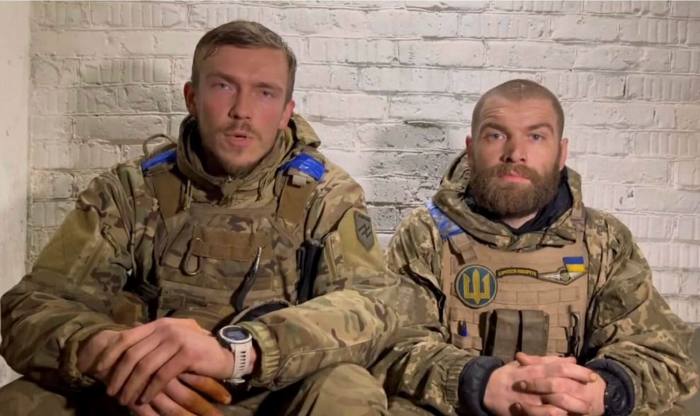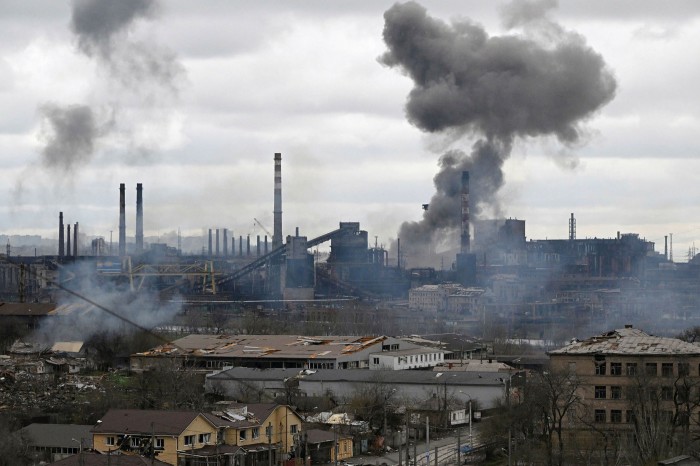For more than seven weeks, invading Russian forces have drawn closer to Mariupol’s centre as they pound it with bombs, artillery and missiles fired from the Black Sea, reducing apartment blocks, hospitals and other buildings to rubble.
The blockaded city’s residents, who numbered more than 400,000 before the invasion, have lived without power, water, communications or modern medical treatment from the beginning of March. Many have run out of food and medicines after shops were looted. Others cook communal meals on open fires.
Throughout it all, analysts have pointed out that Ukraine’s forces were massively outgunned by the Russians and predicted that the city would fall.
But Ukrainian troops — from the military, border guards and the rightwing, nationalist paramilitary Azov Battalion — have held out. They have taken refuge underground in Mariupol’s hulking Soviet-era enterprises, including the Azovstal steel works and parts of the seaport, which have an extensive network of tunnels.
In recent days, the end of the siege has appeared to be drawing closer. On Saturday, Russia’s defence ministry claimed that the city had been cleared of Ukrainian fighters apart from some still blockaded in Azovstal. After midnight, it demanded they surrender.
Russian and Ukrainian military claims made during the war cannot be independently verified.
Capturing Mariupol would give Russian president Vladimir Putin’s struggling Ukraine campaign a huge lift by allowing Moscow to complete a land bridge between Crimea and the cities it occupies in southern Ukraine. It would also free up resources for Moscow’s expected offensive in the Donbas.
For Ukrainians, holding on to Mariupol has become symbolic of the nation’s resistance against an invasion that has killed thousands of civilians and inflicted hundreds of billions of dollars worth of damage.
Azov’s Telegram channel released a video last week in which Denys Prokopenko, commander of the city’s Azov regiment, said the “real men who chose the path of war” were still defending the city. He denounced those who had surrendered as choosing “the path of shame”.
In the video, shot against a brick wall, Prokopenko sat beside Serhii Volyna, commander of the 36th Marine Brigade. The two groups had successfully joined forces to defend Mariupol, he said.

President Volodymyr Zelensky conceded in an interview with Ukrainian media on Saturday that Mariupol’s situation was “definitely not improving”, with its military blocked and many wounded and killed. However, he added: “The boys are heroically defending themselves.”
Igor Yavorsky, a pensioner who was evacuated from Mariupol by bus on Saturday to Zaporizhzhia to the north, said the troops were fighting well “but they need help — military help”.
Fleeing residents, humanitarian workers and other Ukrainians in touch with people in Mariupol painted a picture of a force still holding on at Azovstal and in the port area.
Andriy Biletsky, a founder of Azov, told the Financial Times he believed that from just under 4,000 troops in Mariupol at the start of the invasion, about 2,000 remained active in the city, including those from the Ukrainian marines from the force’s 36th brigade, a large number of Azov combatants, soldiers from the 56th Infantry Brigade, as well as border guards and volunteer fighters.
“As for how they survive, Mariupol is a big city, and there are a large number of big buildings made of reinforced concrete and steel, and a large number of underground passages,” he said. “All of this together helps a bit.”

The fighters were contending with scarce food and drinking water, he said. Ukrainian helicopters had dropped emergency provisions including armaments and medicines via an “air bridge”, although he did not say whether they were still doing so.
Biletsky said doctors and nurses were helping but were working underground with a lack of medicines, including antibiotics and anaesthetic. “This causes a large number of people to die or undergo amputations after gangrene, like in the 19th century,” he said.
Russia’s defence ministry and pro-Russia commentators claimed on April 13 that more than 1,000 Ukrainian marines had surrendered, releasing a video showing dozens of them holding their hands behind their heads.
However, Oleksiy Arestovych, an adviser in Zelensky’s office, said the number who had surrendered was “much less”, adding that some of the marines had joined up with Azov forces.
After midnight on Saturday, Russia’s defence ministry demanded that troops still holding out in Mariupol surrender, “taking into account the catastrophic situation that has developed at the Azovstal metallurgical plant, as well as being guided by purely humanitarian principles”. The lives of all those who laid down their arms would be spared, it said.

In a blockaded city with few journalists and heavily damaged communications, confirming facts is difficult. Residents who have remained, thought to number as many as 100,000, have shared reports and images on social media despite connectivity problems.
In his interview on Saturday, Zelensky cited an estimate by Mariupol’s regional administration that about 20,000 civilians had died, but noted that the official who made the calculation was not in the city.
The Ukrainian president accused Russia of refusing to abide by an agreement for humanitarian corridors from Mariupol during talks brokered by Turkey. “I honestly do not trust the Russian negotiators,” he said.
The International Committee of the Red Cross left Mariupol on March 15 after conditions became “impossible”, said Alyona Synenko, a spokeswoman for the group. The ICRC has struggled to evacuate residents safely via humanitarian corridors because of a lack of agreement between the warring sides, but managed to get more than 1,000 out in a convoy on April 6.
Ukrainian charitable groups have rented private buses and found volunteer drivers willing to risk Russian bombardment and rescue people trapped in the city. According to volunteers in Zaporizhzhia, Russian and pro-Russia separatist troops in Mariupol have been misinforming residents seeking to escape, warning them not to go into Ukrainian territory.
“They say, ‘Your men will be arrested at checkpoints and taken into the army,’” said Oleksandr Sosnovskyi, a volunteer. “They want to evacuate them into Russia.”

According to Lyudmila Denisova, Ukraine’s ombudswoman for human rights, more than 135,000 people from Mariupol have been transferred across the border into Russia since the start of the war.
On Ukrainian territory in Zaporizhzhia, a suburban megastore and garden centre has been converted into a medical facility to receive people arriving from the war zone.
Children arriving at the centre are typically suffering from dehydration, diarrhoea and abdominal pain, and adults from post-traumatic stress, depression and anxiety, according to Wilson Bernales, a volunteer doctor from Las Vegas. “Aside from that, they are all crying because they lost their homes.”
Follow on Twitter: @JohnReedwrites


